
Concept explainers
(a)
Interpretation:
A Lewis structure for
Concept introduction:
Lewis structure is generally considered as a simplified structure of any molecule or atom. Lewis structure for any atom or molecule depicts the valence electrons as dots around the element’s symbol present in the molecule along with the bonds that connect them. Every element tries to complete an octet except the hydrogen atom.
Every element in the Lewis structure tries to attain eight electrons in its valence shell by transfer or share of electrons. This rule is known as the octet rule.
To draw the Lewis structure of the molecule there are following steps:
Step 1: Find the central atom and place the other atoms around it. The atom in a compound which has the lowest group number or lowest electronegativity considered as the central atom.
Step 2: Calculate the total number of valence electrons.
Step 3: Connect the other atoms around the central atoms to the central atom with a single bond and lower the value of valence electrons by 2 of every single bond.
Step 4: Allocate the remaining electrons in pairs so that each atom can get 8 electrons.
Step 5: Convert the lone pair into bond pair.
(a)
Answer to Problem 10.76P
The Lewis structure for
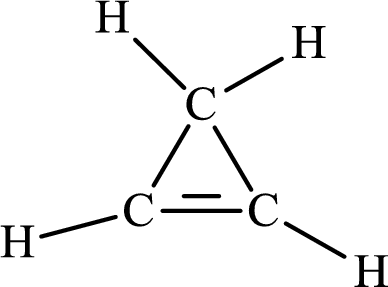
The carbon-carbon single bond has the bond order 1 and carbon-carbon double bond has the bond order 2.
Explanation of Solution
The total number of valence electrons of
Substitute 3 for the total number of
In
The Lewis structure of
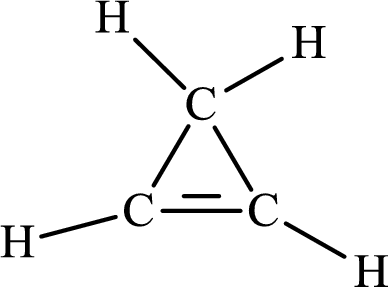
The single bond has the bond order 1 and double bond has the bond order 2. Therefore, the carbon-carbon single bond has the bond order 1 and carbon-carbon double bond has the bond order 2.
The single bond has the bond order 1, the double bond has the bond order 2 and triple bond has the bond order 3.
(b)
Interpretation:
A Lewis structure for
Concept introduction:
Lewis structure is generally considered as a simplified structure of any molecule or atom. Lewis structure for any atom or molecule depicts the valence electrons as dots around the element’s symbol present in the molecule along with the bonds that connect them. Every element tries to complete an octet except the hydrogen atom.
Every element in the Lewis structure tries to attain eight electrons in its valence shell by transfer or share of electrons. This rule is known as octet rule.
To draw the Lewis structure of the molecule there are following steps:
Step 1: Find the central atom and place the other atoms around it. The atom in a compound which has the lowest group number or lowest electronegativity considered as the central atom.
Step 2: Calculate the total number of valence electrons.
Step 3: Connect the other atoms around the central atoms to the central atom with a single bond and lower the value of valence electrons by 2 of every single bond.
Step 4: Allocate the remaining electrons in pairs so that each atom can get 8 electrons.
Step 5: Convert the lone pair into bond pair.
(b)
Answer to Problem 10.76P
The Lewis structure of
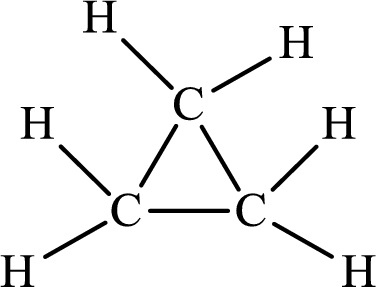
There is only single bond in
Explanation of Solution
The total number of valence electrons of
Substitute 3 for the total number of
In
The Lewis structure of
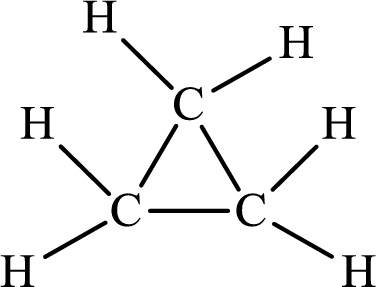
The single bond has the bond order 1 and double bond has the bond order 2. Therefore, there is only single bond in
The single bond has the bond order 1, double bond has the bond order 2 and triple bond has the bond order 3.
(c)
Interpretation:
A Lewis structure for
Concept introduction:
Lewis structure is generally considered as a simplified structure of any molecule or atom. Lewis structure for any atom or molecule depicts the valence electrons as dots around the element’s symbol present in the molecule along with the bonds that connect them. Every element tries to complete an octet except the hydrogen atom.
Every element in the Lewis structure tries to attain eight electrons in its valence shell by transfer or share of electrons. This rule is known as the octet rule.
To draw the Lewis structure of the molecule there are following steps:
Step 1: Find the central atom and place the other atoms around it. The atom in a compound which has the lowest group number or lowest electronegativity considered as the central atom.
Step 2: Calculate the total number of valence electrons.
Step 3: Connect the other atoms around the central atoms to the central atom with a single bond and lower the value of valence electrons by 2 of every single bond.
Step 4: Allocate the remaining electrons in pairs so that each atom can get 8 electrons.
Step 5: Convert the lone pair into bond pair.
(c)
Answer to Problem 10.76P
The Lewis structure of
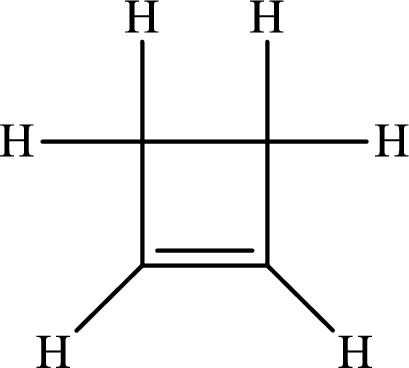
The carbon-carbon single bond has the bond order 1 and carbon-carbon double bond has the bond order 2.
Explanation of Solution
The total number of valence electrons of
Substitute 4 for the total number of
In
The Lewis structure of
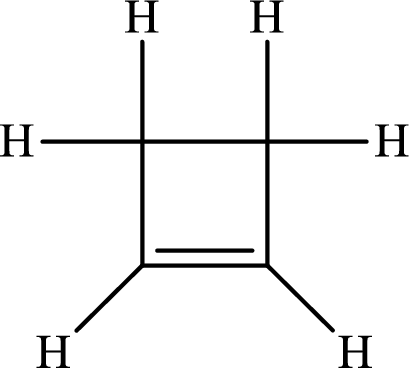
The single bond has the bond order 1 and double bond has the bond order 2. Therefore, the carbon-carbon single bond has the bond order 1 and carbon-carbon double bond has the bond order 2.
The single bond has the bond order 1, the double bond has the bond order 2 and triple bond has the bond order 3.
(d)
Interpretation:
A Lewis structure for
Concept introduction:
Lewis structure is generally considered as a simplified structure of any molecule or atom. Lewis structure for any atom or molecule depicts the valence electrons as dots around the element’s symbol present in the molecule along with the bonds that connect them. Every element tries to complete an octet except the hydrogen atom.
Every element in the Lewis structure tries to attain eight electrons in its valence shell by transfer or share of electrons. This rule is known as the octet rule.
To draw the Lewis structure of the molecule there are following steps:
Step 1: Find the central atom and place the other atoms around it. The atom in a compound which has the lowest group number or lowest electronegativity considered as the central atom.
Step 2: Calculate the total number of valence electrons.
Step 3: Connect the other atoms around the central atoms to the central atom with a single bond and lower the value of valence electrons by 2 of every single bond.
Step 4: Allocate the remaining electrons in pairs so that each atom can get 8 electrons.
Step 5: Convert the lone pair into bond pair.
(d)
Answer to Problem 10.76P
The Lewis structure of

The average bond order in
Explanation of Solution
The total number of valence electrons of
Substitute 4 for the total number of
In
There is alternate single and double present in the ring so the molecule will show resonance.
The Lewis structure of

There are 4 single bonds and 2 double bonds in
The formula to calculate the average bond order in
Substitute 6 for the number of shared electron pair and 4 for the number of bonded atoms in equation (5).
The single bond has the bond order 1, the double bond has the bond order 2 and triple bond has the bond order 3.
(e)
Interpretation:
A Lewis structure for
Concept introduction:
Lewis structure is generally considered as a simplified structure of any molecule or atom. Lewis structure for any atom or molecule depicts the valence electrons as dots around the element’s symbol present in the molecule along with the bonds that connect them. Every element tries to complete an octet except the hydrogen atom.
Every element in the Lewis structure tries to attain eight electrons in its valence shell by transfer or share of electrons. This rule is known as the octet rule.
To draw the Lewis structure of the molecule there are following steps:
Step 1: Find the central atom and place the other atoms around it. The atom in a compound which has the lowest group number or lowest electronegativity considered as the central atom.
Step 2: Calculate the total number of valence electrons.
Step 3: Connect the other atoms around the central atoms to the central atom with a single bond and lower the value of valence electrons by 2 of every single bond.
Step 4: Allocate the remaining electrons in pairs so that each atom can get 8 electrons.
Step 5: Convert the lone pair into bond pair.
(e)
Answer to Problem 10.76P
The Lewis structure of

The average bond order in
Explanation of Solution
The total number of valence electrons of
Substitute 6 for the total number of
In
There is alternate single and double present in the ring so the molecule will show resonance.
The Lewis structure of

There are 6 single bonds and 3 double bonds in
The formula to calculate the average bond order in
Substitute 9 for the number of shared electron pair and 6 for the number of bonded atoms in equation (7).
The single bond has the bond order 1, the double bond has the bond order 2 and triple bond has the bond order 3.
Want to see more full solutions like this?
Chapter 10 Solutions
Chemistry: The Molecular Nature of Matter and Change
- Draw the complete mechanism for the acid-catalyzed hydration of this alkene. esc 田 Explanation Check 1 888 Q A slock Add/Remove step Q F4 F5 F6 A བྲA F7 $ % 5 @ 4 2 3 & 6 87 Click and drag to start drawing a structure. © 2025 McGraw Hill LLC. All Rights Reserved. Terms of Use | Privacy Ce W E R T Y U S D LL G H IK DD 요 F8 F9 F10 F1 * ( 8 9 0 O P J K L Z X C V B N M H He commandarrow_forwardExplanation Check F1 H₂O H₂ Pd 1) MCPBA 2) H3O+ 1) Hg(OAc)2, H₂O 2) NaBH4 OH CI OH OH OH hydration halohydrin formation addition halogenation hydrogenation inhalation hydrogenation hydration ☐ halohydrin formation addition halogenation formation chelation hydrogenation halohydrin formation substitution hydration halogenation addition Ohalohydrin formation subtraction halogenation addition hydrogenation hydration F2 80 F3 σ F4 F5 F6 1 ! 2 # 3 $ 4 % 05 Q W & Å © 2025 McGraw Hill LLC. All Rights Reserved. F7 F8 ( 6 7 8 9 LU E R T Y U A F9arrow_forwardShow the mechanism steps to obtain the lowerenergy intermediate: *see imagearrow_forward
- Soap is made by the previous reaction *see image. The main difference between one soap and another soap isthe length (number of carbons) of the carboxylic acid. However, if a soap irritates your skin, they mostlikely used too much lye.Detergents have the same chemical structure as soaps except for the functional group. Detergentshave sulfate (R-SO4H) and phosphate (R-PO4H2) functional groups. Draw the above carboxylic acidcarbon chain but as the two variants of detergents. *see imagearrow_forwardWhat are the reactions or reagents used? *see imagearrow_forwardWhat are the reactions or reagents used? *see imagearrow_forward
- Provide the mechanism for this transformation: *see imagearrow_forwardAssign all the signals individually (please assign the red, green and blue)arrow_forwardThe two pKa values of oxalic acid are 1.25 and 3.81. Why are they not the same value? Show the protontransfer as part of your explanation. *see imagearrow_forward
 ChemistryChemistryISBN:9781305957404Author:Steven S. Zumdahl, Susan A. Zumdahl, Donald J. DeCostePublisher:Cengage Learning
ChemistryChemistryISBN:9781305957404Author:Steven S. Zumdahl, Susan A. Zumdahl, Donald J. DeCostePublisher:Cengage Learning ChemistryChemistryISBN:9781259911156Author:Raymond Chang Dr., Jason Overby ProfessorPublisher:McGraw-Hill Education
ChemistryChemistryISBN:9781259911156Author:Raymond Chang Dr., Jason Overby ProfessorPublisher:McGraw-Hill Education Principles of Instrumental AnalysisChemistryISBN:9781305577213Author:Douglas A. Skoog, F. James Holler, Stanley R. CrouchPublisher:Cengage Learning
Principles of Instrumental AnalysisChemistryISBN:9781305577213Author:Douglas A. Skoog, F. James Holler, Stanley R. CrouchPublisher:Cengage Learning Organic ChemistryChemistryISBN:9780078021558Author:Janice Gorzynski Smith Dr.Publisher:McGraw-Hill Education
Organic ChemistryChemistryISBN:9780078021558Author:Janice Gorzynski Smith Dr.Publisher:McGraw-Hill Education Chemistry: Principles and ReactionsChemistryISBN:9781305079373Author:William L. Masterton, Cecile N. HurleyPublisher:Cengage Learning
Chemistry: Principles and ReactionsChemistryISBN:9781305079373Author:William L. Masterton, Cecile N. HurleyPublisher:Cengage Learning Elementary Principles of Chemical Processes, Bind...ChemistryISBN:9781118431221Author:Richard M. Felder, Ronald W. Rousseau, Lisa G. BullardPublisher:WILEY
Elementary Principles of Chemical Processes, Bind...ChemistryISBN:9781118431221Author:Richard M. Felder, Ronald W. Rousseau, Lisa G. BullardPublisher:WILEY





